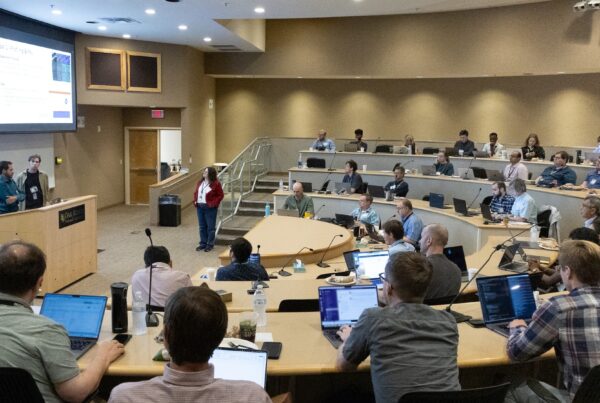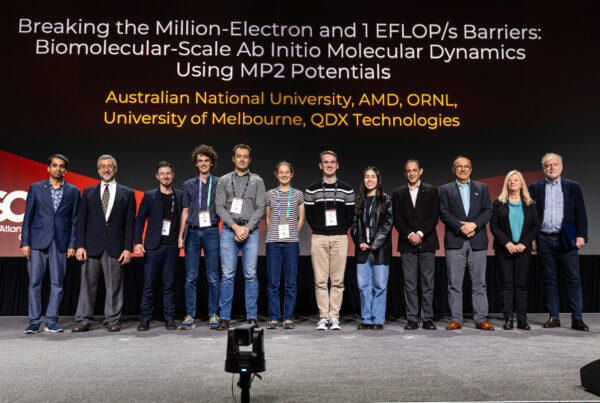From BOFs to blogs, center staff stays busy

(From L to R) Suzy Tichenor, director of ORNL’s industrial partnerships program, Tom Tabor, of Tabor Communications, Jeff Nichols, ORNL’s associate laboratory director for computing and computational sciences, and Jack Wells, OLCF director of science. The center won three HPC wire awards for its work with industry.
The OLCF and industrial users Ford Motor Company and GE Global Research received 5 awards at SC13, the 25th meeting of the annual leading Supercomputing Conference.
Taking place from November 17–22 in Denver, SC13 brought the world’s leading supercomputing centers together with high-performance computing (HPC) users, developers, and sponsors from academia, industry, and government laboratories around the world.
The conference allowed participants to share knowledge and plans through a wide variety of venues and events, including tutorials, workshops, panel discussions, invited talks, research poster sessions, technical paper presentations, and birds-of-a-feather sessions.
For their collaboration and innovation addressing challenging industrial research problems, HPCwire, a leading publication for supercomputing news, recognized the OLCF, Ford, and GE with two Editor’s Choice Awards and one Readers’ Choice Award.
The Editor’s Choice Award for the best use of HPC in manufacturing went to GE and the OLCF for research to better understand ice formation at the atomic level. Using the OLCF’s Titan supercomputer, researchers for the first time simulated hundreds of millions of water molecules freezing in slow motion. New insights into how ice forms will help GE develop wind turbines that are better able to withstand debilitating ice accumulation in cold climates.
Ford and the OLCF were recognized with an Editor’s Choice Award for the best use of HPC in automotive research and a Readers’ Choice Award for the best HPC collaboration between government and industry. Using the OLCF’s Jaguar and Titan systems, Ford optimized for the first time the underhood airflow in automobiles to reduce cooling drag and increase fuel efficiency.
Ford and GE also received the International Data Corporation’s HPC Innovation Excellence Award for this research done on the OLCF’s supercomputing systems. This year’s award marks the second win for GE which was recognized last year for modeling on the OLCF’s Jaguar system the unsteady air flows in the blade rows of turbomachines.
Ford and GE gained access to the OLCF’s supercomputers through a program at ORNL called Accelerating Competitiveness through Computational Excellence, or ACCEL. This industrial partnership program aims to help companies boost competitiveness through easy access to the lab’s world-class computational resources and expertise.
OLCF staff member Jack Dongarra also won the 2013 Ken Kennedy Award.
Outside of the awards, the OLCF and ORNL once again continued their leadership role at the conference.
ORNL staff helped pave the way for this exciting event through leadership roles on the organizing committee. They were also immersed in the conference itself.
For example, birds-of-a-feather sessions, also known as BOFs, allowed participants to gather and discuss topics of common interest. ORNL chaired this portion of the SC agenda and OLCF members lead several of the BOF sessions: Director of Science Jack Wells moderated the session “High-Performance Communications for High-Performance Computing,” user assistance specialist Fernanda Foertter moderated “Women in HPC Around the World,” and INCITE manager Julia White moderated “INCITE and Leadership-Class Systems.”
ORNL staff also stayed busy in workshops and tutorials, both as moderators and presenters, and presented their research findings in papers and posters.
The OLCF also participated on the exhibit floor, staffing Exhibition Booth #1327 with other Department of Energy research laboratories.
Other areas of involvement include: participation in the SC Job Fair to help recruit new staff to the OLCF; a website so that those that could not attend SC could follow the events; content and staffing for the DOE booth, a collaboration among the 17 labs; live-blogging of events by OLCF staff; and the construction and hosting of the backend infrastructure for DOE’s SC website.
For more information https://www.olcf.ornl.gov/sc13/





